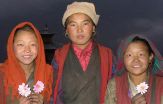(Press-News.org) Overwhelmed by speculators trying to cash-in on a prized medicinal fungus known as Himalayan Viagra, two isolated Tibetan communities have managed to do at the local level what world leaders often fail to do on a global scale — implement a successful system for the sustainable harvest of a precious natural resource, suggests new research from Washington University in St. Louis.
"There's this mistaken notion that indigenous people are incapable of solving complicated problems on their own, but these communities show that people can be incredibly resourceful when it's necessary to preserve their livelihoods," said study co-author Geoff Childs, PhD, associate professor of anthropology in Arts & Sciences.
Writing in the current issue of the journal Himalaya, Childs and Washington University anthropology graduate student Namgyal Choedup describe an innovative community resource management plan that some conservative capitalists might view as their worst regulatory nightmare.
In one remote village, for weeks in advance of the community-regulated harvest season, all able-bodied residents are required to show their faces at a mandatory roll call held four-times daily to ensure that no one is sneaking off into the nearby pastures to illegally harvest the precious fungus.
While regulations such as these might seem overly authoritarian, they've been welcomed by community residents desperate to get a grip on chaos associated with feverish demand for yartsa gunbu, a naturally-occurring "caterpillar fungus" prized in China for reported medical benefits. Use of the fungus as an aphrodisiac has earned it the nickname Himalayan Viagra.
Yartsa gunbu (literally 'summer grass, winter worm'; Ophiocordyceps sinensis) results from a fungal infection that invades the bodies of ground-burrowing ghost moth caterpillars. In early spring, pinky-sized spores of the fungus emerge from the caterpillars' mummified bodies and pop up in remote grassland pastures across the Tibetan Plateau.
View slideshow: https://news.wustl.edu/news/Pages/27447.aspx
Located high in the Himalayan foothills along Nepal's northern Gorkha District border with China's Tibet Autonomous Region (TAR), the tiny rural communities of Nubri and Tsum have been ignored by economic developers for decades — schools, roads and medical facilities are few and far between. Residents have long had little access to cash, with most scraping by on meager incomes from farming, grazing, timber sales and odd jobs.
With yartsa gunbu fetching more per ounce than gold in some Chinese markets, many villagers now reap as much as 80 percent of their annual income during the caterpillar fungus spring harvest season.
Although local incomes are still modest by Western standards, residents have seen average annual incomes rise from an average of a few hundred dollars to upwards of $4,000. But along with these riches has come serious concerns about the impact of money and outsiders on local traditions and the fragile alpine environment in which yartsa gunbu thrives.
Recent news coverage has focused on community tensions and infighting over harvesting practices, the flood of outsiders seeking to take part in the harvest and allegations of graft and bribery among community leaders.
In June 2014, a clash with police left two dead in a dispute between members of the local community and a National Park Buffer Zone Management Committee over who has the right to collect and keep fees paid by outsiders for access to yartsa gunbu grounds. Two more people died in a 2013 fight between Tibetan groups near Rebgong, China.
Meanwhile, outside experts warn that over-harvest of the fungus could cause irreparable damage to fragile high-mountain pastures, with some suggesting yartsa gunbu production already had declined by 40 percent.
Despite dire predictions, research by Childs and Choedup suggests that local communities are rising to the challenge. Their study documents how the residents of Tsum and Nubri have built on existing religious and cultural traditions to devise incredibly cooperative and creative systems to self-manage and regulate the community's annual fungus harvest.
The communities' harvest protocols, they argue, represent an indigenous form of regulatory management, one that may prove sustainable and equitable over the long-term.
Grounded in the resident's traditional rights to use surrounding pasturelands for grazing and other purposes, the yartsa gunbu management plans strive to manage the resource wisely while affording all residents a fair chance to share in the bounty.
Key components of the plans include:
* Restricting yartsa gunbu harvest to members of local households regardless of where they currently reside.
* Sizeable penalties for those caught harvesting outside of the community-enforced season; preseason roll calls require able-bodied residents to check in at local meeting house four times daily (7 a.m., 10 a.m., 2 p.m. and 6 p.m.)
* Requiring harvesters to register with their local villages and pay a small tax to finance projects that support the harvest.
* Prohibiting yartsa gunbu harvest on mountain slopes long considered sacred, thus establishing conservation sanctuaries that will help preserve fungus breeding populations.
Childs and Choedup's research documents a rise in social concerns associated with the sudden rise in incomes, but also finds many positive impacts on the lives of local residents.
The harvest provides an opportunity for people to improve their standard of living, start business ventures, enhance religious life, provide better education for children, and mitigate the economic burden associated with deaths in the family — improvements that have been made without the help of state-sponsored development initiatives, they argue.
"In the case of Nubri and Tsum, management practices that were devised independent of state interference may prove to be sustainable over the long-run," Childs said. "Although many observers have called for more government intervention in the harvesting and sale of yartsa gunbu, our research demonstrates that, at least in some communities, it is better to allow locals to manage the resource and reap the benefits on their own terms."
INFORMATION:
The Antarctic ozone hole reached its annual peak size on Sept. 11, according to scientists from NASA and the National Oceanic and Atmospheric Administration (NOAA). The size of this year's hole was 24.1 million square kilometers (9.3 million square miles) — an area roughly the size of North America.
The single-day maximum area was similar to that in 2013, which reached 24.0 million square kilometers (9.3 million square miles). The largest single-day ozone hole ever recorded by satellite was 29.9 million square kilometers (11.5 million square miles) on Sept. 9, 2000. ...
NASA's Hubble Space Telescope has picked up the faint, ghostly glow of stars ejected from ancient galaxies that were gravitationally ripped apart several billion years ago. The mayhem happened 4 billion light-years away, inside an immense collection of nearly 500 galaxies nicknamed "Pandora's Cluster," also known as Abell 2744.
The scattered stars are no longer bound to any one galaxy, and drift freely between galaxies in the cluster. By observing the light from the orphaned stars, Hubble astronomers have assembled forensic evidence that suggests as many as six galaxies ...
A UAlberta team has discovered that a protein that plays a critical role in metabolism, the process by which the cell generates energy from foods, is important for the development of pulmonary hypertension, a deadly disease.
Pulmonary hypertension is caused by the narrowing of the blood vessels in the lung, due to excessive growth of cells in the blood vessel wall. The cells grow in number until they obstruct the vessels, causing the heart to struggle pushing blood through the lungs to the point where the heart fails and the patient dies.
Evangelos Michelakis, a professor ...
Seizures and migraines have always been considered separate physiological events in the brain, but now a team of engineers and neuroscientists looking at the brain from a physics viewpoint discovered a link between these and related phenomena.
Scientists believed these two brain events were separate phenomena because they outwardly affect people very differently. Seizures are marked by electrical hyperactivity, but migraine auras -- based on an underlying process called spreading depression -- are marked by a silencing of electrical activity in part of the brain. Also, ...
The impact vitamin A has on newborns is virtually unknown, but Penn State nutrition researchers have published two papers that may provide a framework for future investigations of the vitamin and neonatal health.
After supplementing newborn rats with vitamin A, the researchers found that vitamin A distribution within the body increases suddenly but temporarily, with a significant amount found in tissues other than the liver. Vitamin A in adults is usually found in significant amounts in the liver.
Nutrition experts know that vitamin A is necessary for prenatal growth ...
Soon, many will turn back the hands of time as part of the twice-annual ritual of daylight saving time. That means remembering to change the alarm clock next to the bed, which will mean an extra hour of sleep before getting up in the morning.
But for some diabetics who use insulin pumps, Saleh Aldasouqi, associate professor of medicine at Michigan State University, suggests that remembering to change the time on this device should be the priority.
"Some diabetes patients who use insulin pumps may forget to change the clock that is found in these devices," said diabetes ...
MADISON, Wis. — Wisconsin is famous for its ice fishers — the stalwarts who drill holes through lake ice in the hope of catching a winter dinner. Less well known are the state's big-league ice drillers — specialists who design huge drills and use them to drill deep into ice in Greenland and Antarctica, places where even summer seems like winter.
The quarry at these drills includes some of the biggest catches in science.
A hot-water drill designed and built at the University of Wisconsin-Madison's Space Science and Engineering Center (SSEC) and the ...
Philadelphia, PA, October 30, 2014 – A common complication, gestational diabetes affects approximately 6-7% of pregnant women. Currently, screening is done in two steps to help identify patients most at risk; however, the suggested levels for additional testing were based on singleton pregnancy data. Now investigators have analyzed data from twin pregnancies and have determined that the optimal first step cutoff for additional screening appears to be a blood sugar level equal to or greater than 135 mg/dL for women carrying twins. Their findings are published in the ...
MAYWOOD, Ill. (Date) – During the first 24 hours after a stroke, attention to detail --such as hospital bed positioning -- is critical to patient outcomes.
Most strokes are caused by blood clots that block blood flow to the brain. Sitting upright can harm the patient because it decreases blood flow and oxygen to the brain just when the brain needs more blood.
Thus, it's reasonable to keep patients lying flat or as nearly flat as possible, according to a report in the journal MedLink Neurology by Loyola University Medical Center neurologist Murray Flaster, MD, ...
(Santa Barbara, Calif.) — Architecture imitates life, at least when it comes to those spiral ramps in multistory parking garages. Stacked and connecting parallel levels, the ramps are replications of helical structures found in a ubiquitous membrane structure in the cells of the body.
Dubbed Terasaki ramps after their discoverer, they reside in an organelle called the endoplasmic reticulum (ER), a network of membranes found throughout the cell and connected to and surrounding the cell nucleus. Now, a trio of scientists, including UC Santa Barbara biological physicist ...





